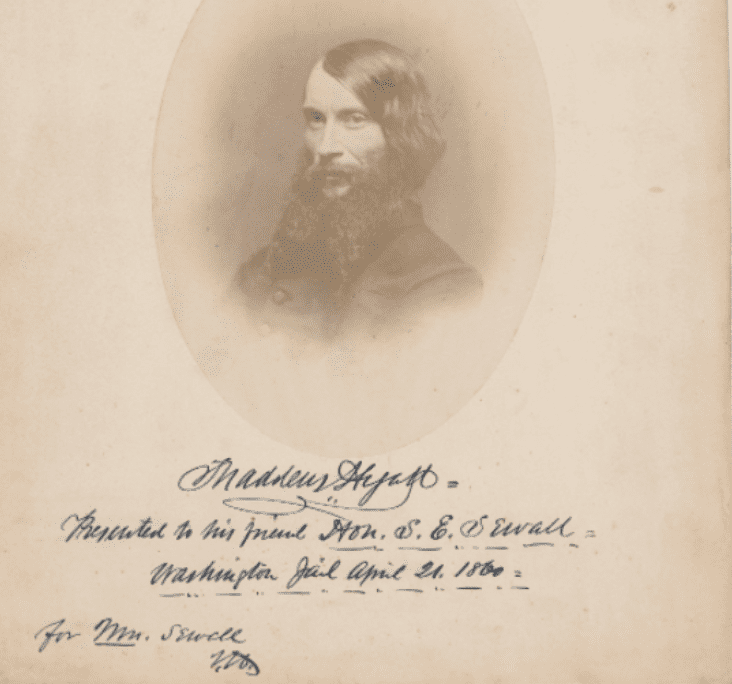 This photograph of abolitionist and inventor Thaddeus Hyatt was sent to his Massachusetts lawyer and fellow abolitionist Samuel E. Sewall in April of 1860 from Hyatt’s cell in a jail in Washington, DC.
This photograph of abolitionist and inventor Thaddeus Hyatt was sent to his Massachusetts lawyer and fellow abolitionist Samuel E. Sewall in April of 1860 from Hyatt’s cell in a jail in Washington, DC.
He wrote below his image, “Presented to his friend, Mon. S. E. Sewall, Washington Jail, April 21, 1860.”
Born in Rahway, NJ, in 1816, Hyatt became a prosperous New York manufacturer before the age of 40 by inventing a translucent paving glass.
Hyatt became actively involved in the abolitionist movement after Congress passed the Kansas-Nebraska Act in 1854. That year he helped organize and named President the New York Kansas League, one of several state-level organizations formed to provide aid to anti-slavery settlers moving to Kansas. The Kansas-Nebraska Act provided that the residents would decide if there would be legalized slavery in each state.
With other well-known abolitionists (including Gerrit Smith), Hyatt organized the National Kansas Committee in July 1856 and was elected president.
A letter from Kansas Gov. John W. Geary to William L. Marcy, United States secretary of state in 1856, related Hyatt’s personal role in Kansas relief: “A party of some ninety men, mostly disbanded militia, have gone in charge of Thaddeus Hyatt, with provisions and necessary tools, to found the town of Hyattville [Anderson county]. . . . These persons were out of employment, likely to become a charge upon the town of Lawrence, and Mr. Hyatt projected this scheme to furnish them with useful employment, and prevent them from falling into habits of indolence and vice.”
It was through this phase of his activities that Hyatt became acquainted with John Brown. The National Kansas Committee and Hyatt supported Brown’s ideology of militant abolitionism, providing him with financial support, and Brown often visited Hyatt’s house in New York.
After John Brown’s failed abolitionist raid on the Harpers Ferry, Virginia armory in 1859, the US Senate launched an investigation to find those who had helped Brown.
 Hyatt, who had established a fund to aid John Brown’s family in the Adirondack Mountains of New York State, was brought to Washington where he ultimately refused to comply with the Congressional subpoena. The Senate voted to jail the recalcitrant abolitionist for contempt.
Hyatt, who had established a fund to aid John Brown’s family in the Adirondack Mountains of New York State, was brought to Washington where he ultimately refused to comply with the Congressional subpoena. The Senate voted to jail the recalcitrant abolitionist for contempt.
Confined in the old Capitol Prison at Washington, Hyatt furnished his cell to his own taste, bought his own food, received visitors, and wrote articles for newspapers during the three months of his imprisonment. He served three months before the investigation ended and he was released.
He seemed to take pride in being locked up, having checks emblazoned with the jail’s return address printed up, mailing “at home” cards to friends and politicians in Washington, and sending out his photograph to various friends inscribed from the Washington Jail.
According to his obituary in the New York Times, “Instead of taking his imprisonment seriously [Hyatt] had his prison room decorated and furnished and then issued invitations to his friends. He never lacked visitors.”
In June 1860, and in 1861 Thaddeus Hyatt went to France to serve as American Consul at LaRochelle, where he served until 1865. While in Paris, Hyatt was arrested on suspicion of being Giuseppe Garibaldi, the Italian patriot to whom he bore a close resemblance.
After his consulship he divided his time between the US and Europe, crossing the Atlantic 43 times before his death.
In England he became a pioneer in the cement industry, building what was said to be the first concrete house in London in 1874.
In the later years of his life Hyatt resided in the United States and kept a summer home on the Isle of Wight, where he died in 1901 at the age of 85.
The Thaddeus Hyatt Collection is a collection of accounts and correspondence given by Hyatt to the Kansas State Historical Society. The majority of the material is from 1854 and 1861, including notable accounts of Bleeding Kansas and his connections with John Brown.
Illustrations, from above: Detail of portrait of abolitionist Thaddeus Hyatt signed from the Washington, DC jail (Massachusetts Historical Society). You can view the portrait up close at the Society’s webpage here; and Thaddeus Hyatt from Frank Leslie’s Illustrated Newspaper, March 31, 1860.


